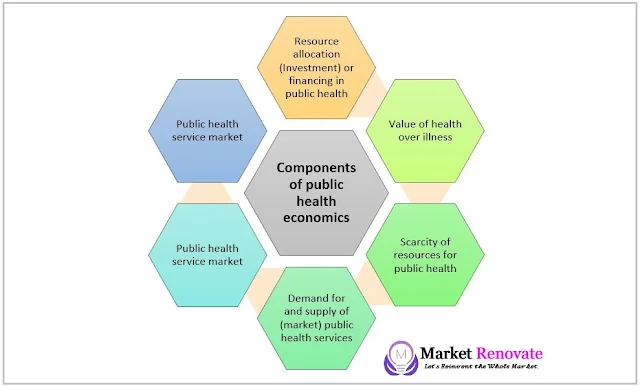Highlights of Basic Scope or Components of Public Health Economics
Public health economics is a critical field that analyzes the efficient allocation of resources to improve population health outcomes. This article provides a comprehensive overview of the fundamental scope and components of public health economics. It covers the value of health over illness, the scarcity of resources in public health, demand and supply of public health services, the functioning of the public health service market, resource allocation and financing in public health, and the process of public health sector budgeting.
This knowledge is essential for students pursuing health education to understand the economic principles underlying effective public health policymaking.
- Value of Health over Illness: Public health economics places a central emphasis on promoting health rather than solely treating illnesses. This approach recognizes that maintaining and improving the health of the population is more economically beneficial in the long run. By investing in preventive measures, health promotion, and disease control, societies can mitigate the economic burden of treating avoidable illnesses. Quantifying the value of health improvements through methods like Quality-Adjusted Life Years (QALYs) or Disability-Adjusted Life Years (DALYs) helps policymakers in making decisions about resource allocation.
- Scarcity of Resources for Public Health: Public health interventions are faced with the reality of limited resources, necessitating a careful allocation to achieve maximum health benefits. Resources include financial funds, human capital, medical supplies, and technological infrastructure. The concept of scarcity requires policymakers to prioritize interventions based on cost-effectiveness analyses and health impact assessments. This principle underscores the need for evidence-based decision-making in public health economics.
- Demand for and Supply of Public Health Services: The demand for public health services is influenced by various factors, including demographics, disease prevalence, socioeconomic status, and health literacy. Economic principles dictate that as the price of public health services decreases, demand tends to increase. On the other hand, the supply of public health services is determined by the availability of healthcare facilities, healthcare professionals, and government policies. Balancing the demand and supply of public health services is crucial to ensure equitable access to healthcare and effective population health management.
- Public Health Service Market: Public health economics recognizes that public health services, despite often being provided by the government or non-profit organizations, can be analyzed through market dynamics. In this context, the public health service market refers to the interaction between the demand for health services and the supply of healthcare resources. Concepts like competition, economies of scale, and efficiency play a role in understanding how the market operates. Understanding the market aspects of public health helps in identifying potential inefficiencies and designing appropriate policy interventions.
- Resource Allocation (Investment) or Financing in Public Health: Effective resource allocation is a cornerstone of public health economics. Policymakers must determine the most efficient and equitable way to invest resources in different health interventions. This involves comparing the costs and benefits of various programs and choosing those that yield the greatest health improvements per unit of resources spent. Additionally, financing in public health examines how healthcare systems are funded, including taxation, insurance schemes, public-private partnerships, and international aid.
- Public Health Sector Budgeting: Budgeting in public health involves the process of planning and allocating financial resources to fulfill public health objectives. This requires a comprehensive understanding of the costs associated with healthcare services, preventive measures, research, and administrative functions. Policymakers must prioritize interventions based on evidence, cost-effectiveness, and the overall impact on population health. Efficient budgeting ensures that the limited resources are utilized optimally to achieve the desired health outcomes.
- Cost-Benefit of Public Health: Cost-benefit analysis is a crucial tool used in public health economics to assess the efficiency of various interventions. It involves comparing the costs of implementing a specific public health program against the expected benefits it generates. These benefits may include reduced healthcare expenditures, increased productivity, and improvements in quality of life. By quantifying costs and benefits in monetary terms, policymakers can determine whether a particular intervention is financially viable and offers a positive net impact. Cost-benefit analysis helps prioritize interventions that yield the greatest health gains relative to their costs, ensuring the optimal use of limited resources.
- Equity (Vertical and Horizontal) in Public Health: Equity is a fundamental principle in public health economics that emphasizes fair and just distribution of healthcare resources and services across the population. Vertical equity focuses on providing more resources and services to those with greater health needs or lower socioeconomic status to reduce health disparities. Horizontal equity, on the other hand, aims to treat individuals in similar health circumstances equally. Achieving both vertical and horizontal equity is a complex endeavor, as it requires balancing resource allocation to cater to vulnerable populations while avoiding discrimination against others. Public health policymakers must consider equity principles to ensure that healthcare services are accessible to all, regardless of their socioeconomic background.
- Economic Evaluation at Public Health Core Actions Level: Economic evaluation is a systematic approach used to assess the value and efficiency of specific public health interventions at the core actions level. Core actions refer to the fundamental activities undertaken in public health, such as immunization campaigns, disease screening, health education, and environmental interventions. Economic evaluation methods, such as cost-effectiveness analysis (CEA) and cost-utility analysis (CUA), help policymakers identify interventions that deliver the best health outcomes relative to their costs. By comparing different core actions, decision-makers can prioritize the most effective strategies to achieve desired public health goals within budgetary constraints.






Please leave your comments or ask your queries here. The comments shall be published only after the Admin approval.